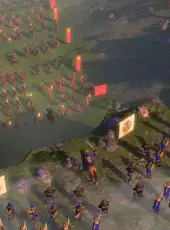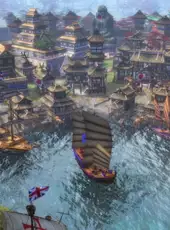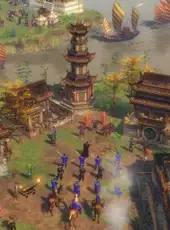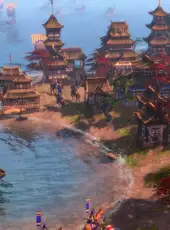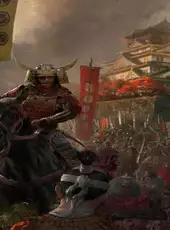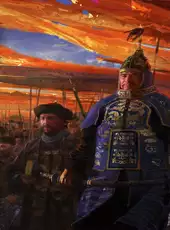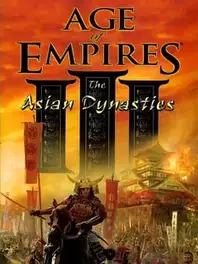
80%
Age of Empires III: The Asian Dynasties
Genres:
Strategy, Simulator, Real Time Strategy (RTS)
Platforms:
PC (Microsoft Windows), Mac
Campaigns
There are three new campaigns, one for each new civilization. Furthermore, these campaigns return to the historical, civilization-based single-player campaigns, which are different from the past campaigns in the Age of Empires III series. Each campaign consists of five new scenarios. They are the first campaigns in the Age of Empires III series to not revolve around the fictional Black family.
Japanese campaign — The Japanese campaign focuses on the unification of Japan (the beginning of which was also a scenario in Age of Empires II: The Conquerors), the establishment of the Tokugawa Shogunate, which players control, and a young general named Sakuma Kichiro. Apparently, when Kichiro was a baby, Tokugawa Ieyasu rescued him from the ruins of his conquered village and raised him as his adopted son. The campaign begins when Kichiro meets up with Daimyō Torii Mototada, at the siege of Osaka (transported from 1615 to 1600) to capture the 5-year-old heir of Hideyoshi. Kichiro and Mototada ally with the local villagers and storm the castle. Next, they move to the north-east of Honshu to destroy any villages that might support Tokugawa's enemy, Uesugi Kagekatsu and defeat Uesugi's army. After the victory, in which they suffer heavy losses, Mototada learns that Tokugawa's main enemy, Ishida Mitsunari is threatening Mototada's estate at Fushimi, forcing Mototada to return there. Meanwhile, Kichiro marches his exhausted army west again to take control of the Tokaido Road trade route. In the aftermath of the battle there, a defeated samurai of the Oda clan tells Kichiro that Tokugawa has lied to him since his childhood. Angered, Kichiro kills the samurai, but nevertheless, is still shaken by his words. He returns to Mototada at Fushimi, and asks him the truth of his origins. Mototada replies that while it was Tokugawa who destroyed his village when he was a baby and sentenced his parents to death, he presses Kichiro on obeying the samurai code telling how Tokugawa admired Kichiro's skills since he was a boy and has great faith in him to help him in unifying Japan. Kichiro remains loyal to Tokugawa and helps Mototada at ensuing battle at Fushimi. After Kichiro escorts the non-combatants to safety, he is forced to leave Mototada to fight alone. As the enemy breaches the final defenses, Mototada commits seppuku. Kichiro joins Tokugawa at Sekigahara. After the Battle of Sekigahara ends in victory for them, Tokugawa tells how it was a great achievement for him to become the Shogun and further asks Kichiro, what did he, as a general, gain from it. Kichiro says "the truth" and makes no mention of what he had learnt about his past. It concludes with it showing Kichiro riding his horse alone with a voiceover from Mototada on the importance of loyalty to one's master.
Chinese campaign — The Chinese campaign focuses loosely on the 1421 hypothesis and is about a Chinese treasure ship discovering the New World before Christopher Columbus. The story mainly focuses on Jian Huang, a Ming captain who has long dreamed of seeing the outside world, and his partner and new friend, Lao Chen, a large, powerful, and crude sailor, who are given orders to help expand the Ming Empire. In the initial release of the game, the player's emblems and unit models are representative of the Qing Empire, despite being set in the Ming period. In the beginning, the treasure fleet is attacked by Wokou pirates while still under construction. On orders of the spoiled and selfish Admiral Jinhai, nephew of the unnamed emperor, Huang and Chen save the fleet and eliminate the pirates. The fleet then embarks westward and is next seen to land in a port on the coast of India. There many of the crew, including Huang and Chen, are attacked by soldiers of the Indian Zamorin and flee with part of the fleet to a nearby island where they set up a new base and mount a rescue mission to save Jinhai and the remaining crew who have been captured by the Zamorin's troops and (as they discover) some Chinese defectors. The fleet continues west at Jinhai's insistence, although many ships turn back, and eventually are cast ashore in the Yucatán by a storm. Chen and Huang go to rescue crews of the other ships from hostile Aztec soldiers. When they return, they find that Jinhai has disappeared. Huang suspects that he was captured along with many of the fleet's crewmembers and mounts a rescue mission. Huang and Chen cut through the jungle and rescue many of their comrades, but Jinhai is not among them. Huang's small army of sailors then enters a nearby Aztec city, where they learn that Jinhai has set himself up as an emperor or perhaps a god among the Aztecs and that it was Jinhai who plotted with the Zamorin in India. Huang and Chen escape an ambush by Jinhai's soldiers and flee back to the coast through a series of caves, rescuing more of their crew along the way. Once back at the coast they set up a base and counterattack, defeating and killing Jinhai. After the battle, Huang, Chen, and the surviving crew members scour the beaches for all evidence of their presence and then sail home to China, hoping that no one will ever know they were there.
Indian campaign — The Indian campaign is about the Indian Rebellion of 1857 and deals with a situation very similar to Chayton Black's situation in The Warchiefs campaign: "Shadow". The protagonist is Subedar Nanib Sahir (a portmanteau name of Nana Sahib), a member of the Sepoy regiments who served the British East India Company, who slowly becomes disillusioned by its cruel ways and abuse of Indian citizens. The campaign begins with Nanib and his superior, Colonel George Edwardson, regaining British control of the saltpetre trade in the Punjab. Nanib and Edwardson then march south to Calcutta and defeat the roving bands of arsonists there. At the close of the battle, Nanib convinces a group of arsonists to lay down their weapons and leave, but Edwardson's men ambush and massacre them, leaving Nanib visibly shaken. The conflict of Nanib's loyalty comes to a head when he and his men are ordered by the Colonel Edwardson to use new Enfield Rifles despite the cartridges' greasing with beef tallow and pork fat, which is a taboo to the sepoys' Hindu and Muslim beliefs. Nanib uses one of the rifles to fire a near miss at Edwardson (loosely based on a similar incident involving Mangal Pandey), killing one of his soldiers. Nanib and fellow sepoy Pravar Patel then lead their regiment of sepoy in an attack on the local Company fort by assaulting weapon caches to cause fires and explosions under its foundations. After their victory, Nanib and Pravar quickly rally the local citizens and sepoys, raising enormous forces. Although Nanib denies leadership of the revolt, he and Pravar decide to rescue Bahadur Shah II from British captivity when the Shah declares himself supreme ruler of India. They sneak into Delhi in the dead of night and destroy weapon caches to cause elephant stampedes, which destroy various city gates. Along the way, they find more rebels who help them battle through Delhi, freeing the Shah and escaping into the night. Nanib subsequently leads his forces in an assault on a Company fort commanded by Colonel Edwardson. Nanib destroys or captures the saltpetre sites and plantations supplying Edwardson's forces inside the fort and fends off three counterattacks. Finally, he assaults the fort and captures its outer defenses, including the fixed guns, mortally wounding Edwardson in the process before destroying the fort's command post. When the heat of battle fades, Nanib approaches a dying Edwardson, who threatens and curses the Indians, saying that the Company is a much larger and more powerful force than all of India. Nanib replies by explaining that no military force can kill the Indians' passion for their country. After Edwardson dies, Nanib and Pravar leave to prepare for a long and costly war against the Company, and three rebel sepoys are seen lowering the Company's flag from the nearby flagpost.
There are three new campaigns, one for each new civilization. Furthermore, these campaigns return to the historical, civilization-based single-player campaigns, which are different from the past campaigns in the Age of Empires III series. Each campaign consists of five new scenarios. They are the first campaigns in the Age of Empires III series to not revolve around the fictional Black family.
Japanese campaign — The Japanese campaign focuses on the unification of Japan (the beginning of which was also a scenario in Age of Empires II: The Conquerors), the establishment of the Tokugawa Shogunate, which players control, and a young general named Sakuma Kichiro. Apparently, when Kichiro was a baby, Tokugawa Ieyasu rescued him from the ruins of his conquered village and raised him as his adopted son. The campaign begins when Kichiro meets up with Daimyō Torii Mototada, at the siege of Osaka (transported from 1615 to 1600) to capture the 5-year-old heir of Hideyoshi. Kichiro and Mototada ally with the local villagers and storm the castle. Next, they move to the north-east of Honshu to destroy any villages that might support Tokugawa's enemy, Uesugi Kagekatsu and defeat Uesugi's army. After the victory, in which they suffer heavy losses, Mototada learns that Tokugawa's main enemy, Ishida Mitsunari is threatening Mototada's estate at Fushimi, forcing Mototada to return there. Meanwhile, Kichiro marches his exhausted army west again to take control of the Tokaido Road trade route. In the aftermath of the battle there, a defeated samurai of the Oda clan tells Kichiro that Tokugawa has lied to him since his childhood. Angered, Kichiro kills the samurai, but nevertheless, is still shaken by his words. He returns to Mototada at Fushimi, and asks him the truth of his origins. Mototada replies that while it was Tokugawa who destroyed his village when he was a baby and sentenced his parents to death, he presses Kichiro on obeying the samurai code telling how Tokugawa admired Kichiro's skills since he was a boy and has great faith in him to help him in unifying Japan. Kichiro remains loyal to Tokugawa and helps Mototada at ensuing battle at Fushimi. After Kichiro escorts the non-combatants to safety, he is forced to leave Mototada to fight alone. As the enemy breaches the final defenses, Mototada commits seppuku. Kichiro joins Tokugawa at Sekigahara. After the Battle of Sekigahara ends in victory for them, Tokugawa tells how it was a great achievement for him to become the Shogun and further asks Kichiro, what did he, as a general, gain from it. Kichiro says "the truth" and makes no mention of what he had learnt about his past. It concludes with it showing Kichiro riding his horse alone with a voiceover from Mototada on the importance of loyalty to one's master.
Chinese campaign — The Chinese campaign focuses loosely on the 1421 hypothesis and is about a Chinese treasure ship discovering the New World before Christopher Columbus. The story mainly focuses on Jian Huang, a Ming captain who has long dreamed of seeing the outside world, and his partner and new friend, Lao Chen, a large, powerful, and crude sailor, who are given orders to help expand the Ming Empire. In the initial release of the game, the player's emblems and unit models are representative of the Qing Empire, despite being set in the Ming period. In the beginning, the treasure fleet is attacked by Wokou pirates while still under construction. On orders of the spoiled and selfish Admiral Jinhai, nephew of the unnamed emperor, Huang and Chen save the fleet and eliminate the pirates. The fleet then embarks westward and is next seen to land in a port on the coast of India. There many of the crew, including Huang and Chen, are attacked by soldiers of the Indian Zamorin and flee with part of the fleet to a nearby island where they set up a new base and mount a rescue mission to save Jinhai and the remaining crew who have been captured by the Zamorin's troops and (as they discover) some Chinese defectors. The fleet continues west at Jinhai's insistence, although many ships turn back, and eventually are cast ashore in the Yucatán by a storm. Chen and Huang go to rescue crews of the other ships from hostile Aztec soldiers. When they return, they find that Jinhai has disappeared. Huang suspects that he was captured along with many of the fleet's crewmembers and mounts a rescue mission. Huang and Chen cut through the jungle and rescue many of their comrades, but Jinhai is not among them. Huang's small army of sailors then enters a nearby Aztec city, where they learn that Jinhai has set himself up as an emperor or perhaps a god among the Aztecs and that it was Jinhai who plotted with the Zamorin in India. Huang and Chen escape an ambush by Jinhai's soldiers and flee back to the coast through a series of caves, rescuing more of their crew along the way. Once back at the coast they set up a base and counterattack, defeating and killing Jinhai. After the battle, Huang, Chen, and the surviving crew members scour the beaches for all evidence of their presence and then sail home to China, hoping that no one will ever know they were there.
Indian campaign — The Indian campaign is about the Indian Rebellion of 1857 and deals with a situation very similar to Chayton Black's situation in The Warchiefs campaign: "Shadow". The protagonist is Subedar Nanib Sahir (a portmanteau name of Nana Sahib), a member of the Sepoy regiments who served the British East India Company, who slowly becomes disillusioned by its cruel ways and abuse of Indian citizens. The campaign begins with Nanib and his superior, Colonel George Edwardson, regaining British control of the saltpetre trade in the Punjab. Nanib and Edwardson then march south to Calcutta and defeat the roving bands of arsonists there. At the close of the battle, Nanib convinces a group of arsonists to lay down their weapons and leave, but Edwardson's men ambush and massacre them, leaving Nanib visibly shaken. The conflict of Nanib's loyalty comes to a head when he and his men are ordered by the Colonel Edwardson to use new Enfield Rifles despite the cartridges' greasing with beef tallow and pork fat, which is a taboo to the sepoys' Hindu and Muslim beliefs. Nanib uses one of the rifles to fire a near miss at Edwardson (loosely based on a similar incident involving Mangal Pandey), killing one of his soldiers. Nanib and fellow sepoy Pravar Patel then lead their regiment of sepoy in an attack on the local Company fort by assaulting weapon caches to cause fires and explosions under its foundations. After their victory, Nanib and Pravar quickly rally the local citizens and sepoys, raising enormous forces. Although Nanib denies leadership of the revolt, he and Pravar decide to rescue Bahadur Shah II from British captivity when the Shah declares himself supreme ruler of India. They sneak into Delhi in the dead of night and destroy weapon caches to cause elephant stampedes, which destroy various city gates. Along the way, they find more rebels who help them battle through Delhi, freeing the Shah and escaping into the night. Nanib subsequently leads his forces in an assault on a Company fort commanded by Colonel Edwardson. Nanib destroys or captures the saltpetre sites and plantations supplying Edwardson's forces inside the fort and fends off three counterattacks. Finally, he assaults the fort and captures its outer defenses, including the fixed guns, mortally wounding Edwardson in the process before destroying the fort's command post. When the heat of battle fades, Nanib approaches a dying Edwardson, who threatens and curses the Indians, saying that the Company is a much larger and more powerful force than all of India. Nanib replies by explaining that no military force can kill the Indians' passion for their country. After Edwardson dies, Nanib and Pravar leave to prepare for a long and costly war against the Company, and three rebel sepoys are seen lowering the Company's flag from the nearby flagpost.
Released on Oct 23rd 2007
Summary:
Age of Empires III: The Asian Dynasties is the second expansion pack for the massively popular Age of Empires III. Rule powerful and exotic Japanese, Chinese and Indian civilications of the East. Battle with Samurai, Chinese Banner Armies and devastating war elephant troops and build powerful wonders.Age of Empires III: The Asian Dynasties is the second expansion pack for the real-time strategy video game Age of Empires III developed through a collaboration between Ensemble Studios and Big Huge Games, and published by Microsoft Game Studios. The Mac version was ported over, developed and published by Destineer's MacSoft. The game is the second expansion pack following The WarChiefs. The game introduces three new civilizations; China, Japan, and India. It also introduced minor people, campaigns, maps, and game modes.
×
![]()


